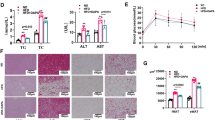Abstract
Uncarboxylated osteocalcin (uOC) is a circulating bone matrix protein, which has previously been shown to regulate glucose uptake and systemic metabolism. However, the cellular mechanism by which uOC acts has yet to be elucidated. C2C12 mouse myotubes were treated for 72 h with uOC (1–100 ng/mL). Cellular metabolism was analyzed using oxygen consumption and extracellular acidification rate. Metabolic gene and protein expression were measured via quantitative real-time polymerase chain reaction and Western blot, respectively. Additionally, C2C12 myotubes were treated with 10 ng/mL uOC to examine glucose uptake and activation of insulin signaling with or without insulin resistance. Finally, cellular lipid content was measured via Oil Red O and Nile Red staining. uOC treatment resulted in dose-dependent alterations of oxygen consumption with little effect on regulators of mitochondrial metabolism. Basal expression of regulators of glucose uptake were unaffected by uOC treatment. However, insulin-stimulated glucose uptake was blunted by uOC treatment with no concurrent alterations in insulin signaling. While chronic insulin treatment resulted in suppressed activation of Akt, concurrent uOC treatment was unable to prevent these detrimental effects on insulin signaling. uOC treatment had no effect on markers of lipogenesis and cellular lipid content. These findings suggest that 72-h uOC treatment may alter oxygen consumption without effect on regulators of mitochondrial biogenesis. Additionally, uOC treatment suppressed insulin-stimulated glucose uptake in cultured myotubes but had little effect on insulin signaling or regulators of cellular metabolism and was unable to mitigate insulin resistance.






Similar content being viewed by others
References
Lee NK, Sowa H, Hinoi E, Ferron M, Ahn JD, Confavreux C, Dacquin R, Mee PJ, McKee M, Jung DY, Zhang Z, Kim JK, Mauvais-Jarvis F, Ducy P, Karsenty G (2007) Endocrine regulation of energy metabolism by the skeleton. Cell 130(3):456–469
Ferron M, Wei J, Yoshizawa T, del Fattore A, DePinho R, Teti A, Ducy P, Karsenty G (2010) Insulin signaling in osteoblasts integrates bone remodeling and energy metabolism. Cell 142(2):296–308
Ferron M, McKee M, Levine RL, Ducy P, Karsenty G (2012) Intermittent injections of osteocalcin improve glucose metabolism and prevent type 2 diabetes in mice. Bone 50(2):568–575
Ferron M, Hinoi E, Karsenty G, Ducy P (2008) Osteocalcin differentially regulates beta cell and adipocyte gene expression and affects the development of metabolic diseases in wild-type mice. Proc Natl Acad Sci U S A 105(13):5266–5270
Hill HS, Grams J, Walton RG, Liu J, Moellering DR, Garvey WT (2014) Carboxylated and uncarboxylated forms of osteocalcin directly modulate the glucose transport system and inflammation in adipocytes. Horm Metab Res 46(5):341–347
Tsuka S, Aonuma F, Higashi S, Ohsumi T, Nagano K, Mizokami A, Kawakubo-Yasukochi T, Masaki C, Hosokawa R, Hirata M, Takeuchi H (2015) Promotion of insulin-induced glucose uptake in C2C12 myotubes by osteocalcin. Biochem Biophys Res Commun 459(3):437–442
Levinger I, Lin X, Zhang X, Brennan-Speranza TC, Volpato B, Hayes A, Jerums G, Seeman E, McConell G (2016) The effects of muscle contraction and recombinant osteocalcin on insulin sensitivity ex vivo. Osteoporos Int 27(2):653–663
Byon JC, Kusari AB, Kusari J (1998) Protein-tyrosine phosphatase-1B acts as a negative regulator of insulin signal transduction. Mol Cell Biochem 182(1–2):101–108
Kenner KA, Anyanwu E, Olefsky JM, Kusari J (1996) Protein-tyrosine phosphatase 1B is a negative regulator of insulin- and insulin-like growth factor-I-stimulated signaling. J Biol Chem 271(33):19810–19816
Tiganis T (2013) PTP1B and TCPTP--nonredundant phosphatases in insulin signaling and glucose homeostasis. FEBS J 280(2):445–458
Wu Z, Puigserver P, Andersson U, Zhang C, Adelmant G, Mootha V, Troy A, Cinti S, Lowell B, Scarpulla RC, Spiegelman BM (1999) Mechanisms controlling mitochondrial biogenesis and respiration through the thermogenic coactivator PGC-1. Cell 98(1):115–124
Kraus NA, Ehebauer F, Zapp B, Rudolphi B, Kraus BJ, Kraus D (2016) Quantitative assessment of adipocyte differentiation in cell culture. Adipocyte 5(4):351–358
Yasutake Y, Mizokami A, Kawakubo-Yasukochi T, Chishaki S, Takahashi I, Takeuchi H, Hirata M (2016) Long-term oral administration of osteocalcin induces insulin resistance in male mice fed a high-fat, high-sucrose diet. Am J Physiol Endocrinol Metab 310(8):E662–E675
del Aguila LF, Claffey KP, Kirwan JP (1999) TNF-alpha impairs insulin signaling and insulin stimulation of glucose uptake in C2C12 muscle cells. Am J Phys 276(5):E849–E855
Nieuwoudt S, Mulya A, Fealy CE, Martelli E, Dasarathy S, Naga Prasad SV, Kirwan JP (2017) In vitro contraction protects against palmitate-induced insulin resistance in C2C12 myotubes. Am J Phys Cell Phys 313(5):C575–C583
Acknowledgments
Support for this work provided by the Department of Exercise Science within the Congdon School of Health Sciences. We would like also to thank the Department of Physical Therapy (Congdon School of Health Sciences) and the Chemistry Department (School of Arts and Sciences) for the use of shared lab space and equipment.
Author information
Authors and Affiliations
Corresponding author
Ethics declarations
Conflict of interest
The authors declare that they have no conflict of interest.
Additional information
Publisher’s note
Springer Nature remains neutral with regard to jurisdictional claims in published maps and institutional affiliations.
Rights and permissions
About this article
Cite this article
Parry, H.A., Rivera, M.E., Vaughan, R.A. et al. Uncarboxylated osteocalcin decreases insulin-stimulated glucose uptake without affecting insulin signaling and regulators of mitochondrial biogenesis in myotubes. J Physiol Biochem 76, 169–178 (2020). https://doi.org/10.1007/s13105-020-00732-6
Received:
Accepted:
Published:
Issue Date:
DOI: https://doi.org/10.1007/s13105-020-00732-6




